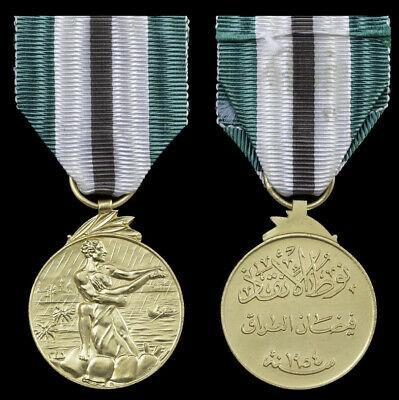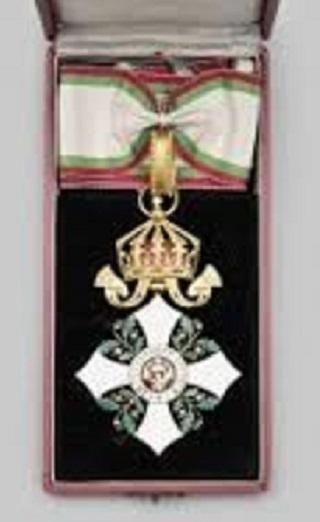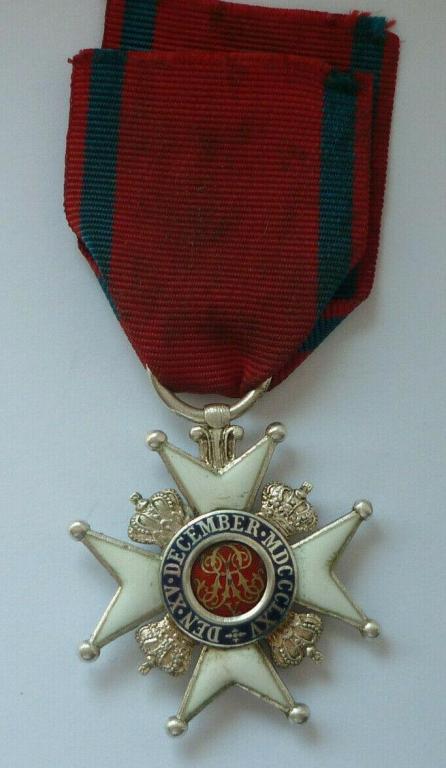
922F
Patron-
Posts
1,397 -
Joined
-
Last visited
-
Days Won
7
Content Type
Profiles
Forums
Blogs
Gallery
Events
Store
Everything posted by 922F
-
Vendor correctly identified this medal: 1954 Kingdom of Iraq Army Flood Rescue Medal aka The Salvation Medal (Nut al-Inqath). King Faisal II established it in 1954 to recognize services performed during the catastrophic floods caused when the Tigris and Euphrates Rivers both burst their banks that year. A number of foreigners received this medal and reserve stocks came on market following the Gulf Wars. Forgot exact translation of reverse. Clear image below--my nearly non-existant Arabic makes out 'Kingdom of Iraq' at top, saving/rescue water in middle & date at bottom. Owain RawRees published a description in the Orders & Medals Society of America's Journal, Volume 57, number 1. Don't remember if Owain translated the inscriptions...either he or Ellie have done so somewhere, perhaps here in GMIC. See also http://www.ghossoub.net/IraqMedals.htm and other Internet sites.
-
Interesting photographs of decorated people
922F replied to ilieff's topic in Central & Eastern European States
Yes, sorry, George VI crowned 12 May 1937, same date as intended for putative Edward VIII...no need to waste the preparation effort or psychological effect perhaps.... -
Interesting photographs of decorated people
922F replied to ilieff's topic in Central & Eastern European States
ilieff, thank you for the image enhancement! Graf, yes, I believe that would confirm the award time/place...just cannot find the image of the group mentioned above and do not recall whether the people in it wore George V coronation medals. Prince Kiril of Bulgaria, Prince of Preslav represented Tsar Boris and led Bulgarian representation at the 1936 [correction--12 May 1937] British coronation. Members of Kiril's delegation likely received George VI coronation medals. I am certain that at least one Bulgarian diplomat/consul stationed in London received that medal. -
Interesting photographs of decorated people
922F replied to ilieff's topic in Central & Eastern European States
Hi Graf, https://en.wikipedia.org/wiki/Coronation_of_George_V_and_Mary#Foreign_royals lists Boris representing Bulgaria and George's third cousin as attending the 1911 Coronation. Somewhere, maybe on Old Bulgaria image site, there's an image of what appears to be the Bulgarian delegation at George V's coronation. At one point, a GMIC member reported that rolls of foreigners awarded British coronation medals could be consulted but another member later wrote these [if they exist] were inaccessible. -
Interesting photographs of decorated people
922F replied to ilieff's topic in Central & Eastern European States
Great images! Thanks to all! Very interesting to see Graf's colorized image of Boris above with a British King George V Coronation medal! -
Thank you, Bayern, for your clear and understandable explanation. I've never see this information offered in such easy to use form and will certainly make use of your work. All best regards
-
Sincere thanks, Bayern, for this information! Epaulettes had me confused!
-
Appears to be a Lion & Sun officer and medal on bottom 'row'. Nicham Iftikhirs could recognize 'donations' to the Tunisian government's Waquf Fund without any other connection to the Beydom. Same for Lion & Sun. Epaulettes curiously do not match. Collar floral decoration not dissimilar to those used by junior French governmental functionaries.
-
Appears to be typical 1880-1920 Ottoman made Osmanie Commander. Enamel in great condition. Full modern made cravats ith ties widely available if desired.
-
Check for marks; may be gold. This piece with so called Pariseren [French] sword quillons - some say these indicate Saxe Altemburg or Saxe Miningen issue. Sachsen-Coburg and Gotha issue usually seen with so called Prussian Sword quillons. Sachsen-Coburg and Gotha issue post WW I swords on ring insignia displayed French quillon swords, however.
-
Bulgarian Orders and Medals - Bulgaria Book Catalog
922F replied to new world's topic in Central & Eastern European States
Are there plans for an English or French language edition? -
Many tailors/technicians who assembled/mounted award bars used whatever scrap or spare ribbon to hand when mounting awards themselves to bars. Then they added the correct ribbon formed into the familiar shape around the award. While the correct ribbon may appear as the award mounting material, most bars I've seen with backing loose or removed display an assortment of varying ribbons or narrow strips of white/gray edge bound narrow cotton tape type material used for that purpose. This to indicate that the color of the red/green ribbon seen protruding beneath the KVK may have nothing to do with the item originally placed there. White with red central stripe ribbon could well be an Ottoman Red Cross [KVK & Verdienstkreuz für Kriegshilfe could support this proposition] or maybe a Spanish MMO, white distinction. In either case, odd that it appears where it does.
-
Bulgaria FAKE BULGARIAN ORDERS ON THE MARKET
922F replied to Graf's topic in Central & Eastern European States
Above crown format usually associated with insignia related to various Christian Eastern Orthodox/Melkite Orders [c.f. Patriarchal Order of the Holy Cross of Jerusalem] and "international" Order groups [c.f. Imperial Order of St. Eugene of Trebizond] these latter usually claiming a relationship with or descent from the Byzantine Empire. Sometimes this type of insignia uses a typical Bulgarian Czarist design suspension crown. -
Japanese officers received various French colonial Orders including at least the Royal Order of Cambodia, Dragon of Annam, and Nichan Iftikir besides the Black Star of Benin. Images of naval personnel, for example, wearing such may be located via: https://www.wikiwand.com/en/List_of_Imperial_Japanese_Navy_admirals. Without in-depth research, hard to say whether some of these awards were protocol awards, recognition for service rendered in respective geographic areas, naval visit honors exchanges, or ???? Images at the website mentioned appear to show concentrations of these colonial decorations in the 1890's and WW I era but a couple seem to be in the 1930's. Do not forget that during WW II Japanese personnel received both Cambodian and Annamese honors from the king and emperor, French collaborationist governments and possibly the Japanese controlled puppet states. During and post WW II, the Black Star of Benin and Ouissan Alaouite were likely the most usual colonial orders used to 'protect' the Legion of Honor but examples when other colonial orders fulfilled this role exist.
-
Hello Owain, Ambassador Abebe's group certainly has found an excellent home. Thank you for sharing this enlightening information!
-
Order of British Empire MBE
922F replied to Noor's topic in Great Britain: Orders, Gallantry, Campaign Medals
Has anyone information on the MBE/OBE manufacturer activity periods? Garrard examples seem to be earliest [1917-?], then Royal Mint [19??-197??] then contractors like Spink, Toye, Kenning & Spenser, Gladman & Norman Ltd, Worcestershire Medal Service and ??? -
Hans-Georg Steltzer (born April 30, 1913 in Braunschweig, died April 12, 1987 in Königswinter), a German soldier, diplomat and writer, served in the Wehrmacht being promoted to major by 1945. Steltzer later became a career Social Democratic Party of Germany politician/bureaucrat. Among his duties, he headed the Federal Press Office in the Foreign Office and worked as a diplomat in Africa and at home. Steltzer left government in 1978-79 but remained active in foreign affairs, especially regarding Africa. He published several books on German-African colonial relations and the Imperial German Fleet. Steltzer served as German ambassador to Egypt and Ghana and received many awards including, at least,: Germany [Federal Republic] Order of Merit, 3rd class; Cameroun Order of Merit, First Class [sash/badge]; Egypt Order of Merit, [Grand Cordon?]; Gabon Order of Merit, Grand Officer; Ghana [Order of Volta?, class unknown]; Ivory Coast Order of National Merit, Commander; Liberia Order of African Redemption, Commander; Madagascar Order of National Merit, Grand Officer; Niger Order of Merit, Grand Officer; Senegal Order of National Merit, Commander. Tunisia Order of the Republic, Grand Officer. Has anyone additional information regarding Steltzer's Wehrmacht service [and possible awards]? Is this list of his post-war decorations accurate and complete? Thanks for your assistance!
-
Cannot determine whether circlet of 'dots' within the central rim are individually crisp & equally spaced. That said, looks OK, note ring suspension attachment & lack of casting marks. C.F. http://www.cimilitaria.com/Danzig Cross.html and other sites.






